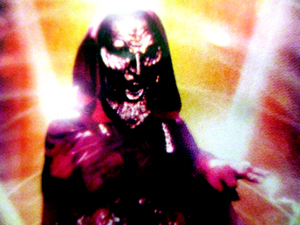The Masque of Mandragora
“The hand of a friend is a subtle but certain weapon.” – Heironymous
This should be a great story for its concepts and ideas: An alien energy helix beyond the scope of measure and understanding stows away part of itself in the TARDIS. Steering it off course to Italy at the start of the Renaissance, it emerges and presents itself as a god to an ancient underground cult, magically resurrecting the ruins of the temple to their former glory and imbuing the followers with power with which they can destroy the progress of man.
As good as it all sounds, the realization of the story itself is nowhere near that remarkable. Right from the start, the key opening effect to the series—the wonder of the Mandragora Helix—is rather unconvincing. On earth, the energy ball never really looks more than what it is—the tip of glowing sparkler filmed over the background of the woods. (Though I have to say the moment where is skitters across the water is pretty well done.) The supposed restoration of the temple was apparently well beyond the show’s budget and their attempt to represent it by backlit painted screens is just not impressive—more like arty theater than TV scifi. Even the shots of the glowing mask and empty cassock of Hieronymous are accomplished by badly framed still shots that don’t hold up to well.
What’s even worse about the story is the direction. There are a lot of scenes where the timing of the action is off or scenes are obviously inserted (like the killing of the dancers in the palace.) The worst example is the sacrifice scene with Sarah where the Doctor (somehow without being seen in plain sight of everyone) steals her away right from under the blade. The cult leader just stands there as if waiting for a cue to suddenly discover her not there. Even the acting is rather lackluster and most of the characters are thus not that compelling.
I do like that we start off with one of our first hints at how large the TARDIS really is inside. Actually, there’s a great discussion of relative dimensions and “how big is big?” to start. (I’m not a fan of the new wood paneled control room though.) Since it had been a while since the show took us into past, I do like the fact that we finally get to enjoy again the rich finery, rosy language, and pageantry of old Europe—especially the costumed dance scene in the palace. On the other hand, the enjoyment is kind of undercut when many of the guards sound like east London dock workers and the royal court seems more English than Italian. Marco’s shock of red hair looks especially out of place (but Hieronymus’s beard and weasley face are pretty cool).
There’s a nice tension to the build-up as Heironymous’s powers start to grow and the Brethern start to gather and then reveal themselves at the masque. (“For years, the wise fools, the scholars of the new knowledge, have jeered and scoffed at me…But they will learn their mistake, priest. They will learn their mistake as they die.”) Unfortunately, the end of the story comes far too abruptly after that and the revelation that the Doctor was impersonating the cult leader is shown in a rather silly way.
Best (or worst) unsettling moment:
Marco’s groans of pain at torture are rather disturbing when left to the imagination behind the locked the door. (If it had been in the previous season, they would have been accompanied by graphic detail of his mangled body, but they seemed to have lightened up a bit for this round.) Also both cool and shocking is the corroded state of the corpses.
Firsts:
- The seeming unending maze of the TARDIS
Retrofit:
[It’s interesting that the show seems to (re)answer a longstanding question about how companions can understand the language. It’s described as a “Time Lord gift” shared with them but we also know the TARDIS has language translation circuits from the Pertwee era. Eventually, these two are put together in a way.
Regrets:
So much of the show is a let down from where it could have been. I really am disappointed since the storyline really had potential.

